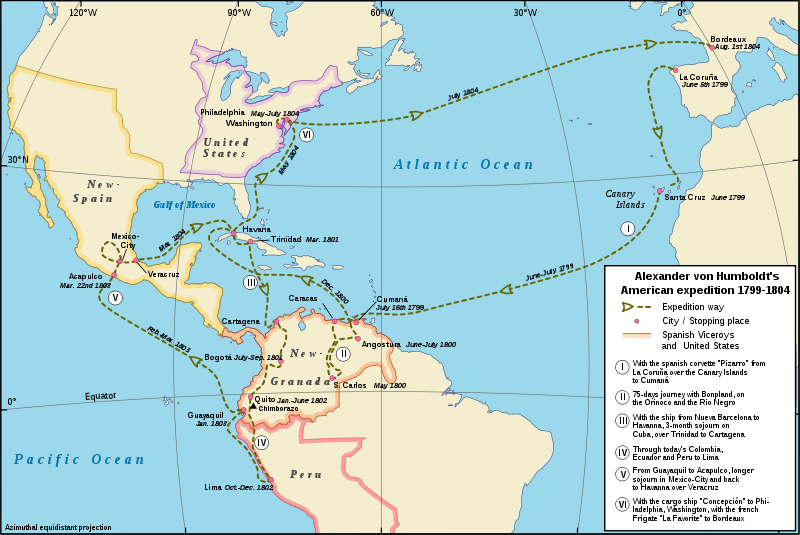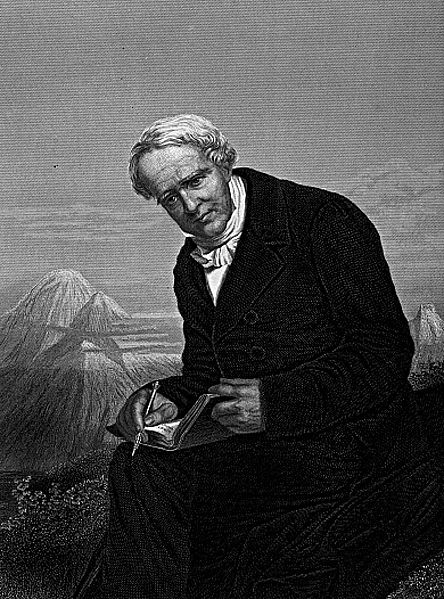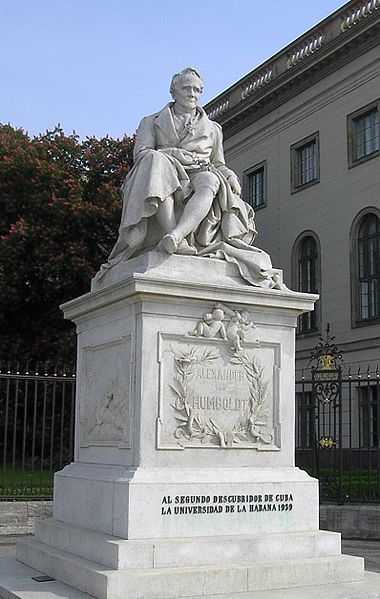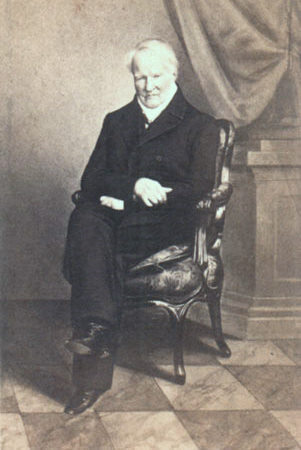<Back to Index>
- Naturalist Friedrich Wilhelm Heinrich Alexander von Humboldt, 1769
- Writer Francisco Gómez de Quevedo y Santibáñez Villegas, 1580
- President of the Republic of Guatemala Jacobo Árbenz Guzmán, 1913
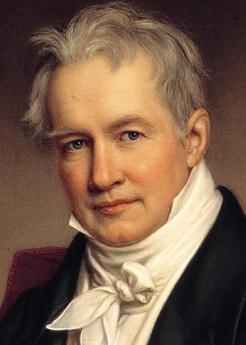
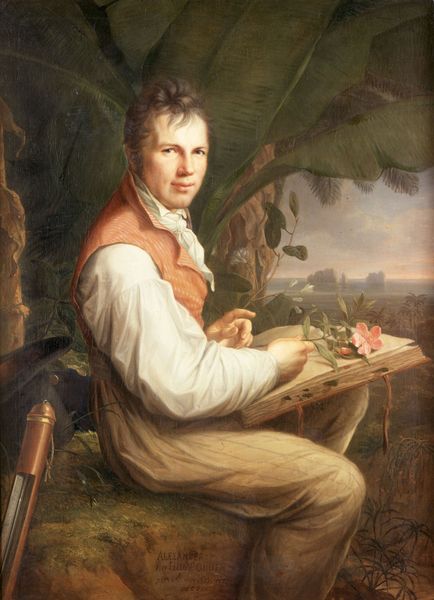
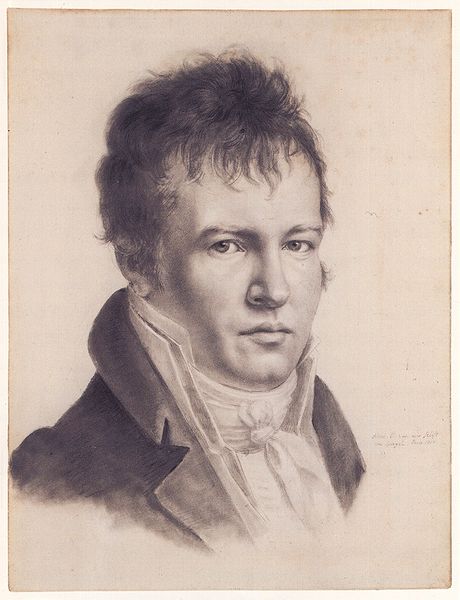
Friedrich Wilhelm Heinrich Alexander Freiherr von Humboldt (September 14, 1769 – May 6, 1859) was a German naturalist and explorer, and the younger brother of the Prussian minister, philosopher, and linguist, Wilhelm von Humboldt (1767-1835). Humboldt's quantitative work on botanical geography was foundational to the field of biogeography.
Between 1799 and 1804, Humboldt traveled extensively in Latin America, exploring and describing it for the first time in a manner generally considered to be a modern scientific point of view. His description of the journey was written up and published in an enormous set of volumes over 21 years. He was one of the first to propose that the lands bordering the Atlantic Ocean were once joined (South America and Africa in particular). Later, his five-volume work, Kosmos (1845), attempted to unify the various branches of scientific knowledge. Humboldt supported and worked with other scientists, including Joseph-Louis Gay-Lussac, Justus von Liebig, Louis Agassiz, Matthew Fontaine Maury, and most notably, Aimé Bonpland, with whom he conducted much of his scientific exploration.
Humboldt was born in Berlin in the Margraviate of Brandenburg. His father, Alexander George von Humboldt, was a major in the Prussian Army and belonged to a prominent Pomeranian family and was rewarded for his services during the Seven Years' War with the post of Royal Chamberlain. He married Maria Elizabeth von Colomb in 1766, the widow of Baron von Holwede, and they had two sons. The money of Baron von Holwede, left to his former wife, was instrumental in the funding of Alexander's explorations, contributing more than 70% of Alexander's monetary income. Due to his penchant for collecting and labeling plants, shells, and insects he received the playful title of "the little apothecary". His father died in 1779, after which his mother took care of his education. Destined for a political career, he studied finance during six months at the University of Frankfurt (Oder); and a year later, on April 25, 1789, he matriculated at Göttingen, then eminent for the lectures of C.G. Heyne and J.F. Blumenbach. His vast and varied interests were by this time fully developed, and during a vacation in 1789, he made a scientific excursion up the Rhine, and produced the treatise Mineralogische Beobachtungen über einige Basalte am Rhein (Brunswick, 1790).
Humboldt's passion for travel was confirmed by friendships formed at Göttingen with Georg Forster, Heyne's son-in-law, the distinguished companion of Captain James Cook on his second voyage. Henceforth his studies and combination of personal talents became to the purpose of preparing himself for a distinctive calling as a scientific explorer. With this view he studied commerce and foreign languages at Hamburg, geology at Technische Universität Bergakademie Freiberg under A.G. Werner, anatomy at Jena under J.C. Loder, and astronomy and the use of scientific instruments under F.X. von Zach and J.G. Köhler. His researches into the vegetation of the mines of Freiberg led to the publication, in 1793, of his Florae Fribergensis Specimen; and the results of a prolonged course of experiments on the phenomena of muscular irritability, then recently discovered by Luigi Galvani, were contained in his Versuche über die gereizte Muskel- und Nervenfaser (Berlin, 1797), enriched in the French translation with notes by Blumenbach.
In 1794 Humboldt was admitted to the intimacy of the famous Weimar coterie, and contributed (June 7, 1795) to Schiller's new periodical, Die Horen, a philosophical allegory entitled Die Lebenskraft, oder der rhodische Genius. In the summer of 1790 he paid a short visit to England in company with Forster. In 1792 and 1797 he was in Vienna; in 1795 he made a geological and botanical tour through Switzerland and Italy.
He had obtained in the meantime official employment: appointed assessor
of mines at Berlin, February 29, 1792. Although this service to the
state was regarded by him as only an apprenticeship to the service of
science, he fulfilled its duties with such conspicuous ability that not
only did he rise rapidly to the highest post in his department, but he
was also entrusted with several important diplomatic missions. The
death of his mother, on November 19, 1796, set him free to follow the
bent of his genius, and severing his official connections, he waited
for an opportunity to fulfil his long-cherished dream of travel. On the postponement of Captain Baudin's proposed voyage of circumnavigation, which he had been officially invited to accompany, Humboldt left Paris for Marseille with Aimé Bonpland, the designated botanist of the frustrated expedition, hoping to join Napoleon Bonaparte in Egypt. Means of transport, however, were not forthcoming, and the two travellers eventually found their way to Madrid, where the unexpected patronage of the minister Don Mariano Luis de Urquijo convinced them to make Spanish America the scene of their explorations. Armed with powerful recommendations, they sailed in the Pizarro from A Coruña, on June 5, 1799, stopped six days on the island of Tenerife to climb Mount Teide, and landed at Cumaná, Venezuela, on July 16. Humboldt visited the mission at Caripe where he found the oil-bird, which he was to make known to science as Steatornis caripensis. Returning to Cumaná, Humboldt observed, on the night of November 11–12, a remarkable meteor shower (the Leonids). He proceeded with Bonpland to Caracas; and in February 1800 they left the coast with the purpose of exploring the course of the Orinoco River.
This trip, which lasted four months, and covered 1,725 miles (2,776 km) of wild and largely uninhabited country, had the
important result of establishing the existence of the Casiquiare canal (a communication between the water-systems of the rivers Orinoco and Amazon), and of determining the exact position of the bifurcation, as well as documenting the life of several native tribes such as the Maipures and their extinct rivals the Atures. Around March 19, 1800, von Humboldt and Bonpland discovered and captured some electric eels.
They both received potentially dangerous electric shocks during their
investigations. Two months later they explored the territory of the
Maypures and that of the then recently extinct Aturès indians. On November 24, the two friends set sail for Cuba, and after a stay of some months they regained the mainland at Cartagena, Colombia. Ascending the swollen stream of the Magdalena, and crossing the frozen ridges of the Cordillera Real, they reached Quito on January 6, 1802, after a tedious and difficult journey. Their stay there was marked by the ascent of Pichincha and an attempt on Chimborazo.
Humboldt and his party reached an altitude of 19,286 feet
(5,878 m), a world record at the time. The journey concluded with
an expedition to the sources of the Amazon en route for Lima, Peru. At Callao, Humboldt observed the transit of Mercury on November 9, and studied the fertilizing properties of guano, the subsequent introduction of which into Europe was due mainly to his writings. A tempestuous sea-voyage brought them to Mexico, where they resided for a year, traveling to different cities. Next, von Humboldt made a short visit to the United States, staying in the White House as a guest of President Thomas Jefferson.
Jefferson, a scientist himself, was delighted to have von Humboldt as a
guest and the two held numerous intense discussions on scientific
matters. After six weeks, von Humboldt set sail for Europe from the
mouth of the Delaware, and landed at Bordeaux on August 3, 1804.
This memorable expedition may be regarded as having laid the foundation of the sciences of physical geography and meteorology.
By his delineation (in 1817) of "isothermal lines", he at once
suggested the idea and devised the means of comparing the climatic
conditions of various countries. He first investigated the rate of
decrease in mean temperature with the increase in elevation above sea
level, and afforded, by his inquiries regarding the origin of tropical
storms, the earliest clue to the detection of the more complicated law
governing atmospheric disturbances in higher latitudes; while his essay
on the geography of plants was based on the then novel idea of studying
the distribution of organic life as affected by varying physical
conditions. His discovery of the decrease in intensity of Earth's magnetic field from
the poles to the equator was communicated to the Paris Institute in a
memoir read by him on December 7, 1804, and its importance was attested
by the speedy emergence of rival claims. His services to geology were
based mainly on his attentive study of the volcanoes of the New World.
He showed that they fell naturally into linear groups, presumably
corresponding with vast subterranean fissures; and by his demonstration
of the igneous origin
of rocks previously held to be of aqueous formation, he contributed
largely to the elimination of erroneous views, such as Neptunism. The
reduction into form and publication of the encyclopædic mass of
scientific, political and archaeological material – collected by him
during his absence from Europe – was now Humboldt's most urgent desire.
After a short trip to Italy with Gay-Lussac for the purpose of investigating the law of magnetic declination,
and a sojourn of two and a half years in his native city, he finally,
in the spring of 1808, settled in Paris with the purpose of securing
the scientific cooperation required for bringing his great work through
the press. This colossal task, which he at first hoped would occupy but
two years, eventually cost him twenty-one, and even then it remained
incomplete. In these early years in Paris, he shared accommodation and
a laboratory with his former rival, and now friend, Joseph-Louis Gay-Lussac, both working together on the analysis of gases and the composition of the atmosphere. Humboldt
is considered to be the "second discoverer of Cuba" due to all the
scientific and social research he conducted on this Spanish colony.
During an initial three-month stay at Havana, his first tasks were to properly survey that city and the nearby towns of Guanabacoa, Regla and Bejucal. He befriended Cuban landowner and thinker Francisco Arrango y Parreño; together they visited the Guines area in south Havana, the valleys of Matanzas Province, and the Valley of the Sugar Mills in Trinidad.
Those three areas were, at the time, the first frontier of sugar
production in the island. During those trips, Humboldt collected
statistical information on Cuba's population, production, technology
and trade, and with Arrango, made suggestions for enhancing them. He
predicted that the agricultural and commercial potential of Cuba was
huge and could be vastly improved with proper leadership in the future.
After traveling to America, Humboldt returned to Cuba for a second,
shorter stay in April 1804. During this time he socialized with his
scientific and landowner friends, conducted mineralogical surveys and
finished his vast collection of the island's flora and fauna. Finally, Humboldt conducted a rudimentary census of the indigenous and European inhabitants in New Spain, and on May 5, 1804, he estimated the population to be six million individuals.
Alexander
Von Humboldt thought a different approach to science was needed; he
wanted an approach that could account for the harmony of nature among
the diversity of the physical world. For Humboldt, “the unity of
nature” meant that interrelation of all physical sciences- such as the conjoining between biology, meteorology, and geology that determined where specific plants grew - which the scientist unraveled by discovering myriad, painstakingly collecting data,
which turned into an enduring foundation for others to follow. Humboldt
viewed nature as a whole. He tried to explain natural phenomena without
the appeal to religious dogma. Humboldt used extensive observation to
get the truth from the natural world. He had a vast array of the most
sophisticated armamentarium of scientific instruments ever before
assembled. Each had its own velvet lined box and was the most accurate
and portable of its time. Essentially everything would be measured with
the finest and most modern instruments and sophisticated techniques
available, for all the collected data was the basis of all scientific
understanding. This methodology would become known as “Humboldtian
science.” Humboldt wrote “Nature herself is sublimely eloquent. The
stars as they sparkle in firmament fill us with delight and ecstasy,
and yet they all move in orbit marked out with mathematical precision.”
His critics say his writings are about fantastical descriptions of America, while leaving out its inhabitants. Coming from the Romantic school of thought, they claim Humboldt believed '...nature is perfect till man deforms it with care.' In
this line of thinking, they think he largely neglected the human
societies amidst this nature. The writing style that describes the 'new
world' without people is a trend among explorers both of the past and
present. Views of indigenous peoples as 'savage' or 'unimportant'
leaves them out of the historical picture. In
reality Humboldt dedicated large parts of his work to describing the
conditions of slaves, Indians and society in general. He often showed
his disgust for the slavery and inhumane conditions in which Indians
and others were treated and often criticized the colonial policies.
Humboldt was now one of the most famous men in Europe. The acclaimed American painter Rembrandt Peale painted
him during his stay, between 1808 and 1810, as one of the most
prominent figures in Europe at the time. A chorus of applause greeted
him from every side. Academies, both native and foreign, were eager to
enroll him among their members. He was elected a foreign member of the Royal Swedish Academy of Sciences in 1810. King Frederick William III of Prussia conferred
upon him the honour, without exacting the duties, attached to the post
of royal chamberlain, together with a pension of 2,500 thalers,
afterwards doubled. He refused the appointment of Prussian minister of
public instruction in 1810. In 1814 he accompanied the allied
sovereigns to London. Three years later he was summoned by the king of
Prussia to attend him at the congress of Aachen. Again in the autumn of 1822 he accompanied the same monarch to the congress of Verona, proceeded thence with the royal party to Rome and Naples, and returned to Paris in the spring of 1823. Humboldt
had long regarded the French capital as his true home. There he found,
not only scientific sympathy, but the social stimulus which his
vigorous and healthy mind eagerly craved. He was equally in his element
as the lion of the salons and as the savant of the institute and the
observatory. During that time he met in 1818, the young and brilliant
Peruvian student of the Royal Mining School of Paris, Mariano Eduardo de Rivero y Ustariz.
They became good friends. Subsequently von Humboldt acted as a mentor
of the career of this promising Peruvian scientist. Thus, when at last
he received from his sovereign a summons to join his court at Berlin,
he obeyed indeed, but with deep and lasting regret. The provincialism
of his native city was odious to him. He never ceased to rail against
the bigotry without religion, aestheticism without culture, and
philosophy without common sense, which he found dominant on the banks
of the Spree. The unremitting benefits and sincere attachment of two well-meaning
princes secured his gratitude, but could not appease his discontent. At
first he sought relief from the "nebulous atmosphere" of his new abode
by frequent visits to Paris; but as years advanced, his excursions were
reduced to accompanying the monotonous "oscillations" of the court
between Potsdam and
Berlin. On May 12, 1827 he settled permanently in the Prussian capital,
where his first efforts were directed towards the furtherance of the
science of terrestrial magnetism. For many years, it had been one of
his favourite schemes to secure, by means of simultaneous observations
at distant points, a thorough investigation of the nature and law of "magnetic storms" (a term invented by him to designate abnormal disturbances of Earth's magnetism).
The meeting at Berlin, on September 18, 1828, of a newly-formed
scientific association, of which he was elected president, gave him the
opportunity of setting on foot an extensive system of research in
combination with his diligent personal observations. His appeal to the
Russian government, in 1829, led to the establishment of a line of
magnetic and meteorological stations across northern Asia. Meanwhile
his letter to the Duke of Sussex, then (April 1836) president of the Royal Society, secured for the undertaking, the wide basis of the British dominions. The Encyclopædia Britannica,
Eleventh Edition, observes, "Thus that scientific conspiracy of nations
which is one of the noblest fruits of modern civilization was by his
exertions first successfully organized." However, earlier examples of
international scientific cooperation exist, notably the 18th-century
observations of the transits of Venus.
In 1811, and again in 1818, projects of Asiatic exploration
were proposed to Humboldt, first by the Russian government, and
afterwards by the Prussian government; but on each occasion, untoward
circumstances interposed, and it was not until he had begun his
sixtieth year that he resumed his early role of traveller in the
interests of science. Between May and November 1829, he, together with
his chosen associates, Gustav Rose and C.G. Ehrenberg,
traversed the wide expanse of the Russian empire from the Neva to the
Yenesei, accomplishing in twenty-five weeks a distance of
9,614 miles (15,472 km). The journey, however, though carried
out with all the advantages afforded by the immediate patronage of the
Russian government, was too rapid to be profitable. Its most important
fruits were crab apples, the correction of the prevalent exaggerated
estimate of the height of the Central Asian plateau, and the discovery
of diamonds in the gold-washings of the Ural, a result which Humboldt's
Brazilian experiences enabled him to predict, and by predicting to
secure. Between 1830 and 1848 von Humboldt was frequently employed in diplomatic missions to the court of Louis Philippe, with whom he always maintained the most cordial personal relations. His brother, Wilhelm von Humboldt,
died in Alexander's arms on April 8, 1836. The death saddened the later
years of his life; Alexander lamented that he had lost half of himself
with the death of his brother. Upon the accession of the crown prince Frederick William IV in
June 1840, Humboldt's favour at court increased. Indeed, the new king's
craving for Humboldt's company became at times so importunate as to
leave him only a few waking hours to work on his writing. The first two volumes of the Kosmos were
published between the years 1845 and 1847. Humboldt had been intending
to write a comprehensive work about different facets of geography and
the natural sciences for decades. The writing first took shape in a set
of lectures he delivered before the University of Berlin in the winter of 1827-28. In the words of one biography, these lectures would form "the cartoon for the great fresco of the [K]osmos". The
scope of this work may be described as the representation of the unity
amidst the complexity of nature. Humboldt's work was by and large a
synthesis of Kantian views of unity of natural phenomena. Drawing
together the methods and instrumentation of the discrete sciences and
with inspiration from German Romanticism,
Humboldt sought to create a compendium of the world's environment. The
book was written for an educated audience and contains much
contemporaneous scientific data. The
last decade of his long life — his "improbable" years, as he was
accustomed to calling them — was devoted to the continuation of this
work, of which the third and fourth volumes were published in 1850-58,
while a fragment of a fifth was to appear posthumously in 1862. In
these volumes he sought to elaborate upon the individual branches of
science broadly surveyed in the first volume. Notwithstanding their
high separate value, it must be admitted that, from an artistic point
of view, these additions were deformities. The characteristic idea of
the work, so far as such a gigantic idea admitted of literary
incorporation, was completely developed in its opening portions, and
the attempt to convert it into a scientific encyclopædia was in
truth to nullify its generating motive. Humboldt's remarkable industry
and accuracy were never more conspicuous than in this latest trophy to
his genius. Nor did he rely entirely on his own labours. He owed much
of what he accomplished to his rare power of assimilating thoughts that
were not as his own and availing himself of others' cooperation. The
notes to Kosmos overflow with laudatory citations, the current coin in which he discharged his intellectual debts. Kosmos was
very popular, especially in Britain and USA. In 1849 a German newspaper
mused about the fact that in England two of the three different
translations of this work were made by women, "while in Germany most
of the men do not understand it." The
first had been made by Augustin Pritchard and published anonymous by
Mr. Baillière, volume I in 1845 and volume II in 1848. But it
suffered very much from the hurry it was made in. Humboldt wrote in a
letter on this translation. "It will damage my reputation. All the
charm of my description is destroyed by an English sounding like
Sanskrit." The other two translations were made by Mrs. Sabine under
the superintendence of her Husband Col. Edward Sabine (4
volumes 1846 – 1858), and by Miss E.C. Otté (5 volumes 1849 –
1858, the only complete translation of the 4 German volumes). These
three translations were also published in USA. The numbering of the
volumes differ between the German and the English editions. Volume 3 of
the German edition corresponds to the volumes 3 and 4 of the English
translation, as the German volume appeared in 2 parts in 1850 and 1851.
Volume 5 of the German edition was not translated until 1981, again by
a woman. A
great advantage of the English translation of Miss Otté was its
detailed table of contents, and index for every volume; of the German
edition only volumes 4 and 5 had an extremely short table of contents.
German readers had to wait until the appearance of volume 5 in 1862 for
an index. Not so well known in Germany is the atlas belonging to the German edition of the Cosmos "Berghaus’ Physikalischer Atlas", better known as the pirated version by Traugott Bromme under the title "Atlas zu Alexander von Humboldt’s Kosmos" (Stuttgart 1861). In Britain Heinrich Berghaus planned to publish together with Alexander Keith Johnston a "Physical Atlas". But later Johnston published it alone under the title "The Physical Atlas of Natural Phenomena". In Britain its connection to the Cosmos seems not have been recognized.
On February 24, 1857 Humboldt suffered a minor stroke,
which passed without perceptible symptoms. It was not until the winter
of 1858-1859 that his strength began to decline, and that spring, on
May 6, he died quietly in Berlin at the age of 89. The honours which
had been showered on him during life continued after his death. His
remains, prior to being interred in the family resting-place at Tegel,
were conveyed in state through the streets of Berlin, and received by
the prince-regent at the door of the cathedral. The first centenary of
his birth was celebrated on September 14, 1869, with great enthusiasm
in both the New and Old Worlds. Numerous monuments erected in his
honour, and newly explored regions named after Humboldt, bear witness
to his wide fame and popularity. Much of Humboldt's private life remains a mystery because he destroyed his private letters. In 1908 the sexual researcher Paul Näcke, who worked with outspoken gay activist Magnus Hirschfeld, gathered reminiscences of him from people who recalled his participation in the homosexual subculture of Berlin. A travelling companion, the pious Francisco José de Caldas,
accused him of frequenting houses where 'impure love reigned', of
making friends with 'obscene dissolute youths', and giving vent to
'shameful passions of his heart'. To
be sure, none of this necessarily proves homosexuality. On the question
of homosexuality, author Robert F. Aldrich concludes, "As for so many
men of his age, a definite answer is impossible." Throughout
his life Humboldt formed strong emotional attachments to men. To the
soldier Reinhard von Haeften he wrote: "I know that I live only through
you, my good precious Reinhard, and that I can only be happy in your
presence." He
never married, yet there were two notable exceptions where he seemed to
have been drawn to the opposite sex. The first was an adolescent
infatuation with Henriette Herz, the beautiful wife of Marcus Herz, his mentor, and the second was a short lived but intimate relationship with a woman named Pauline Wiesel in 1808 Paris. He
was strongly attached to his brother's family; and in his later years
the somewhat arbitrary sway of an old and faithful servant held him in
more than matrimonial bondage. By a singular example of generosity (or
some people would say weakness), he executed, four years before his
death, a deed of gift transferring to this man Seifert the absolute
possession of his entire property. No undue advantage appears to have
been taken of this extraordinary concession. His
attachments, once formed, were sincere and lasting. He made innumerable
friends; and it does not stand on record that he ever lost one. His
benevolence was throughout his life active and disinterested. He showed
zeal for the improvement of the condition of the miners in Galicia and Franconia, detestation of slavery, and patronage of rising men of science. The faults of his old age were brought into prominence by the publication of his letters to Varnhagen von Ense.
The chief of these faults was his habit of smooth speaking, almost
amounting to flattery, in contrast with the caustic sarcasm of his
confidential utterances. His vanity, at all times conspicuous, was
tempered by his sense of humour, and was so frankly avowed as to invite
sympathy rather than provoke ridicule.
Matthew Fontaine Maury subsequently revealed that Brazil had
ordered the arrest of Alexander von Humboldt if Humboldt ever came
there — that great European scientist, Alexander von Humboldt, who had
traveled elsewhere in South America. This alone, Maury said, showed the
stupidity of the closed door policy.
